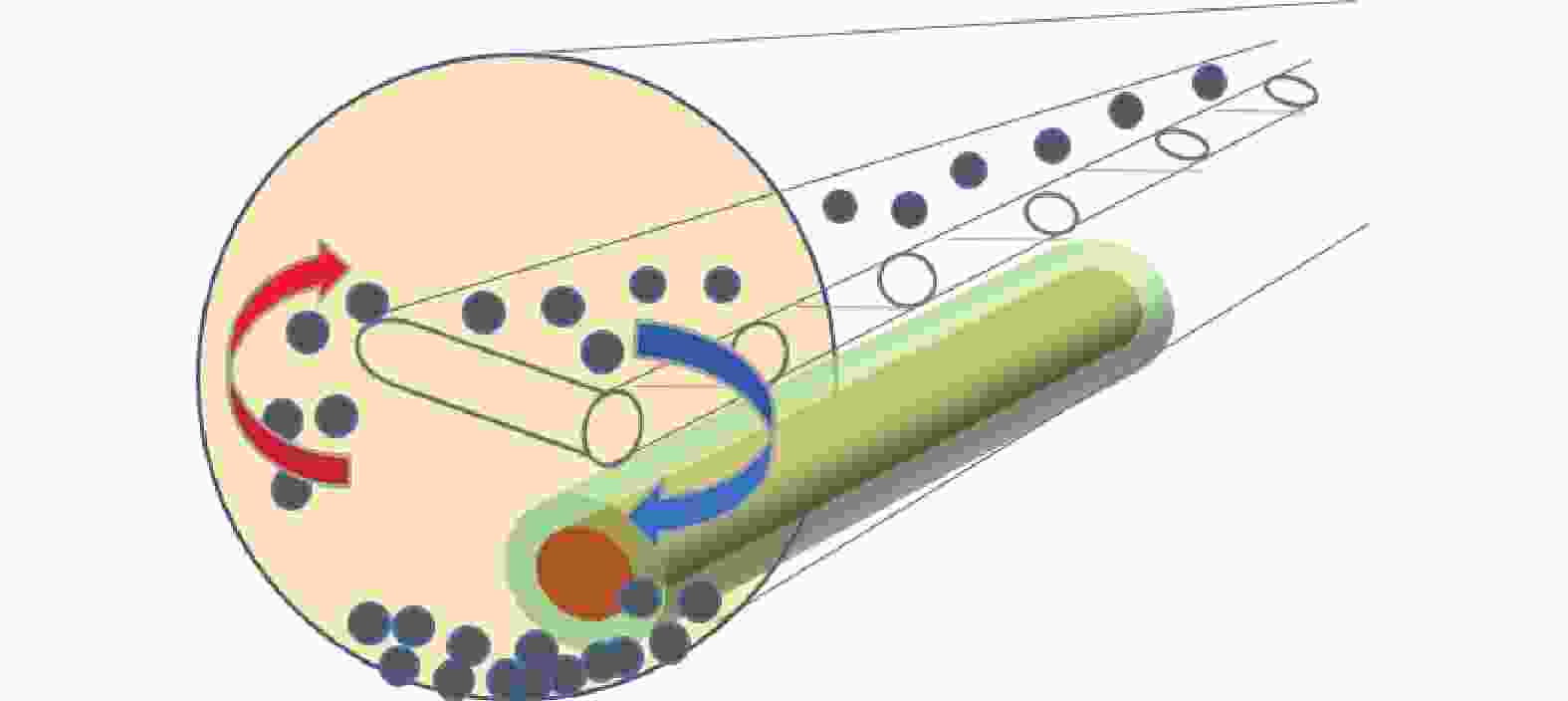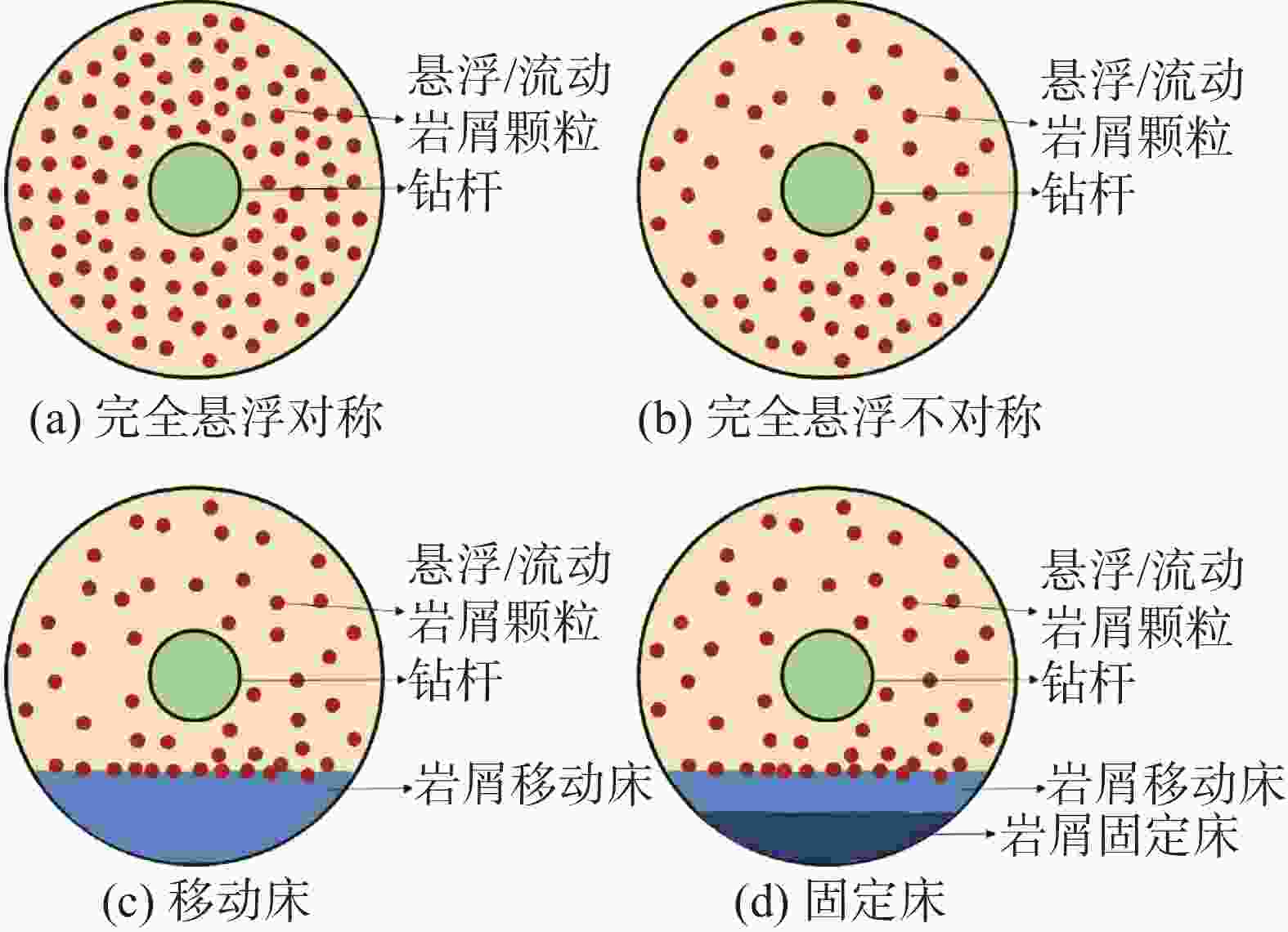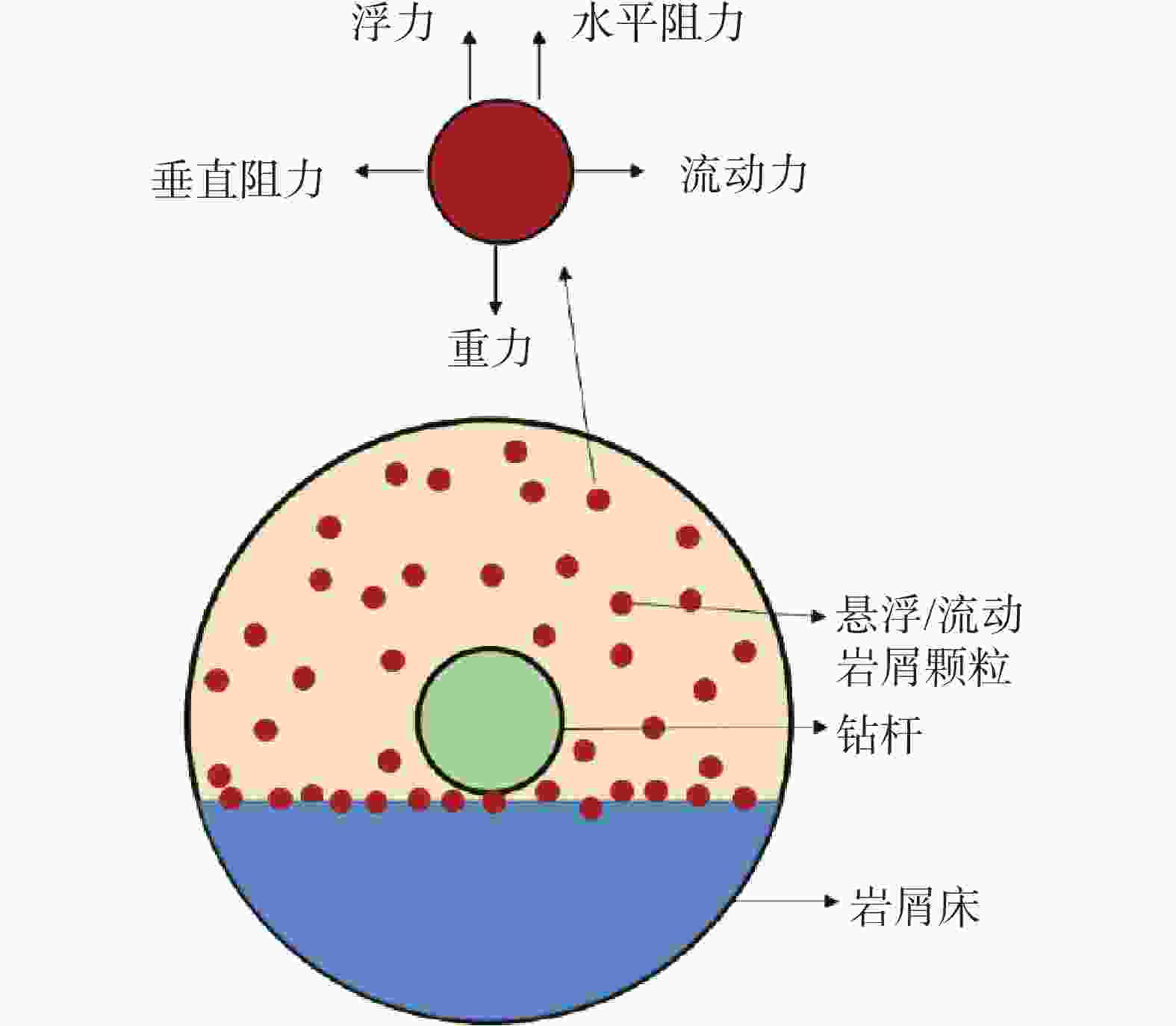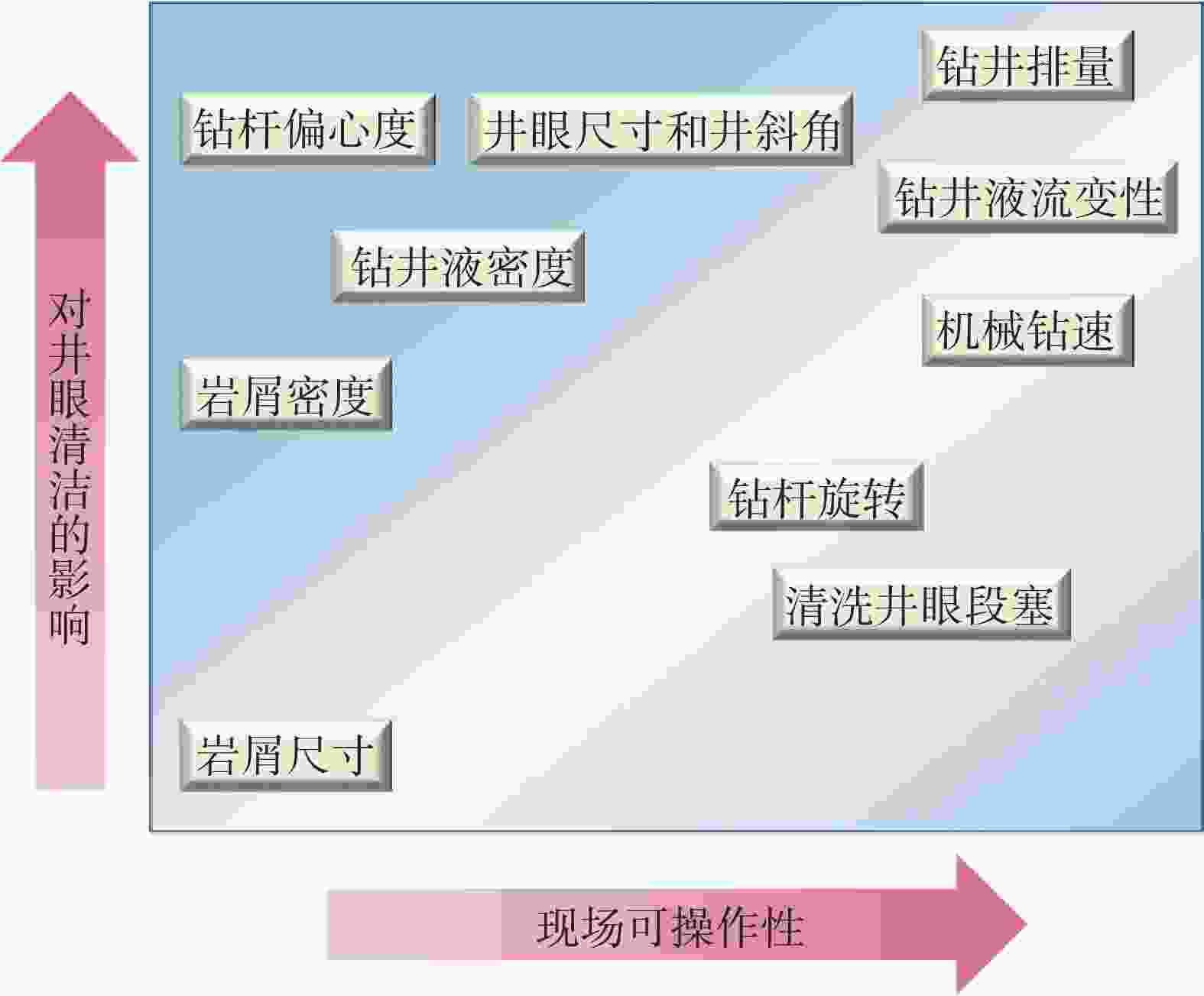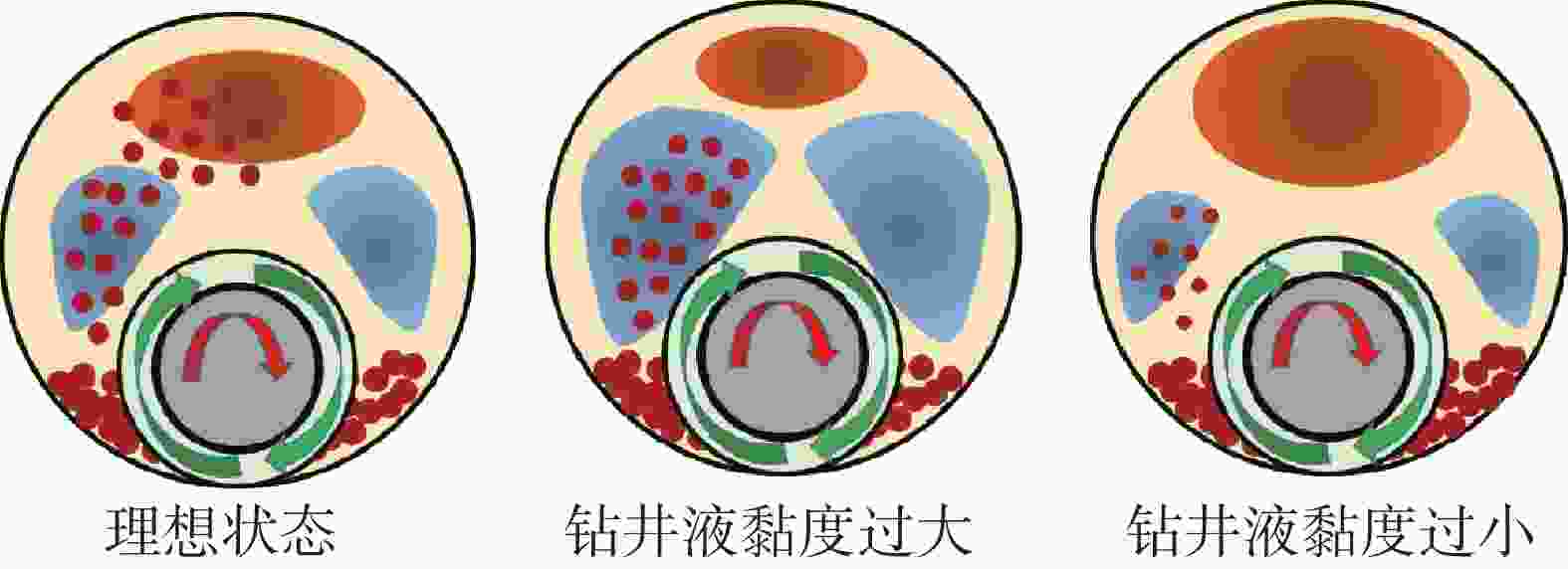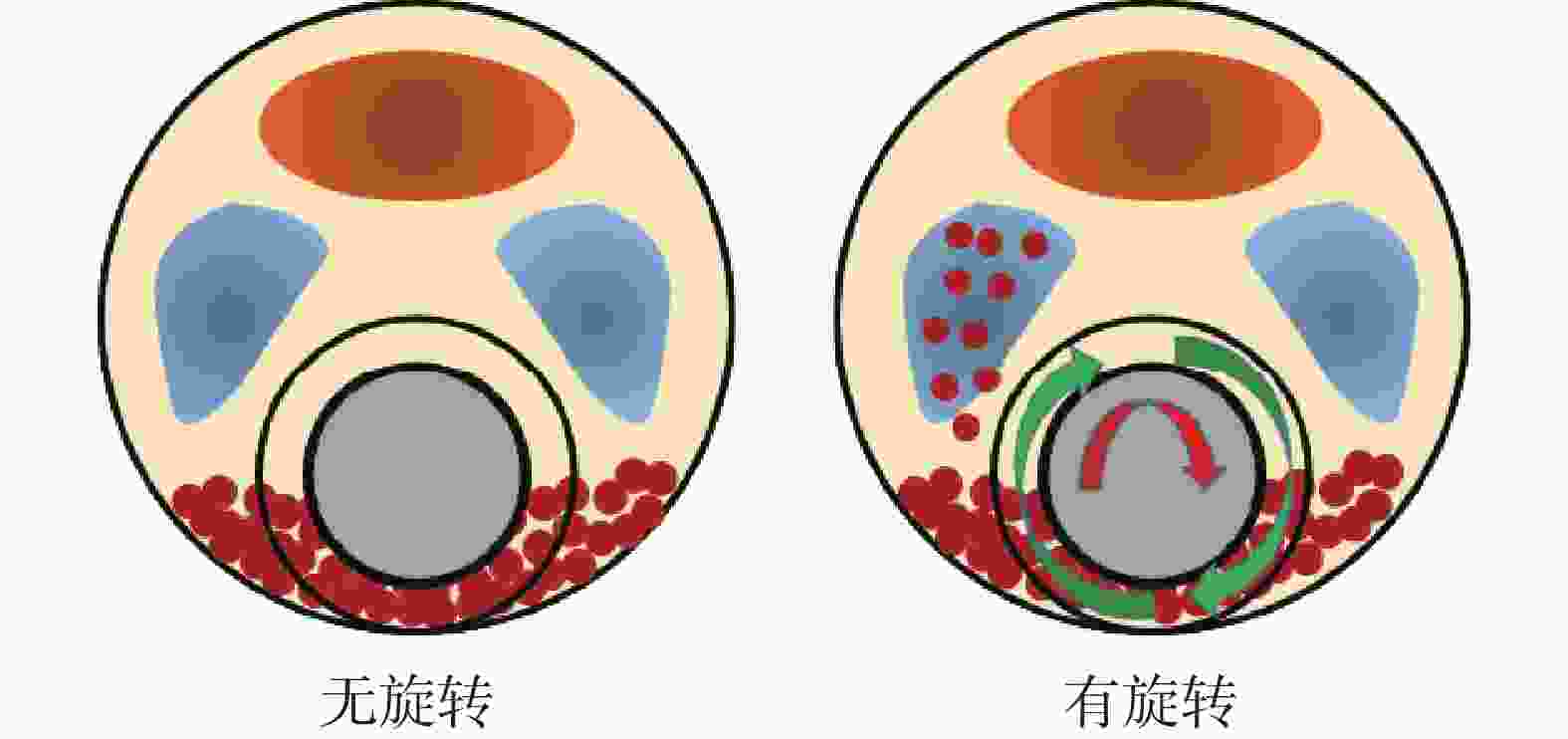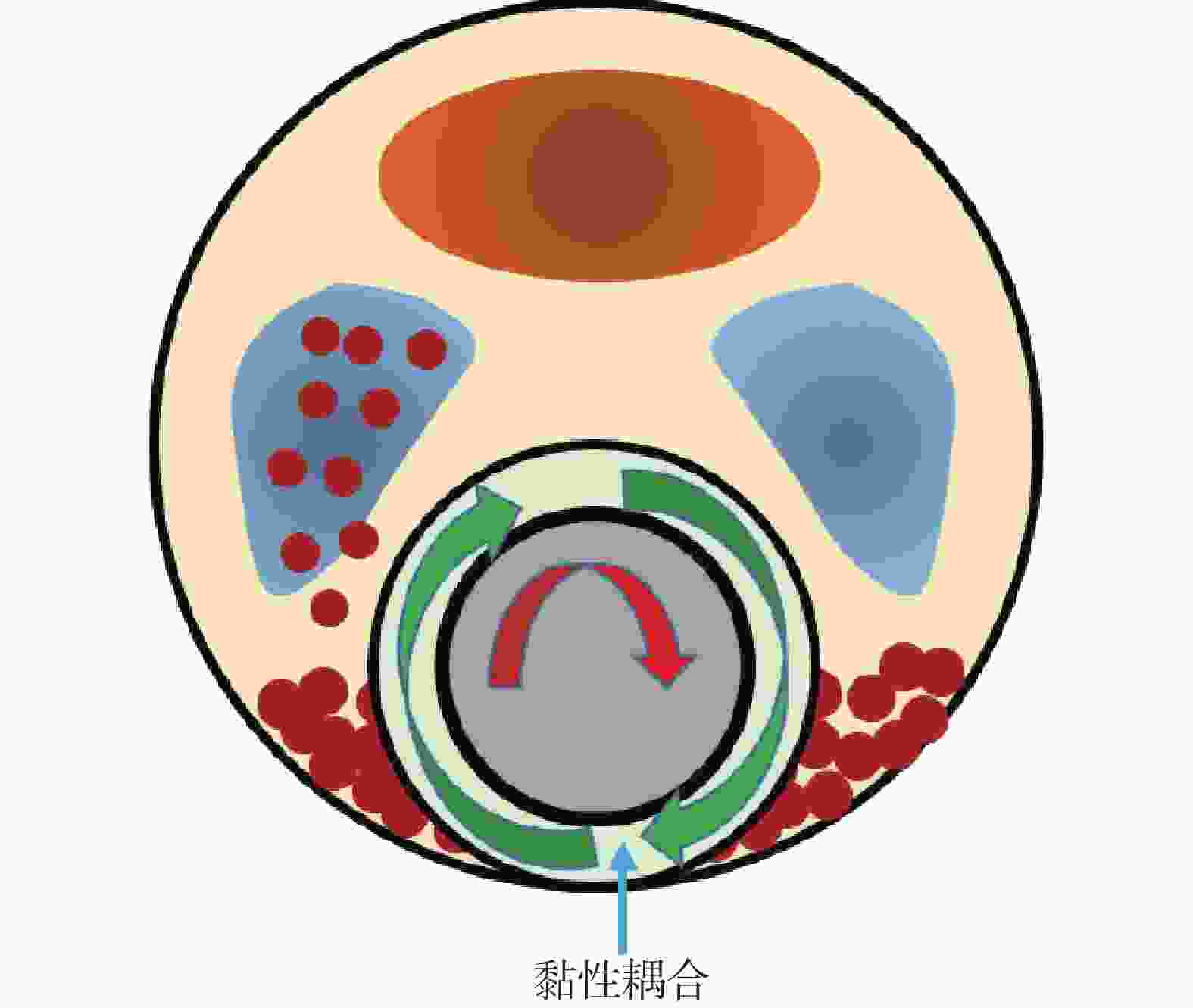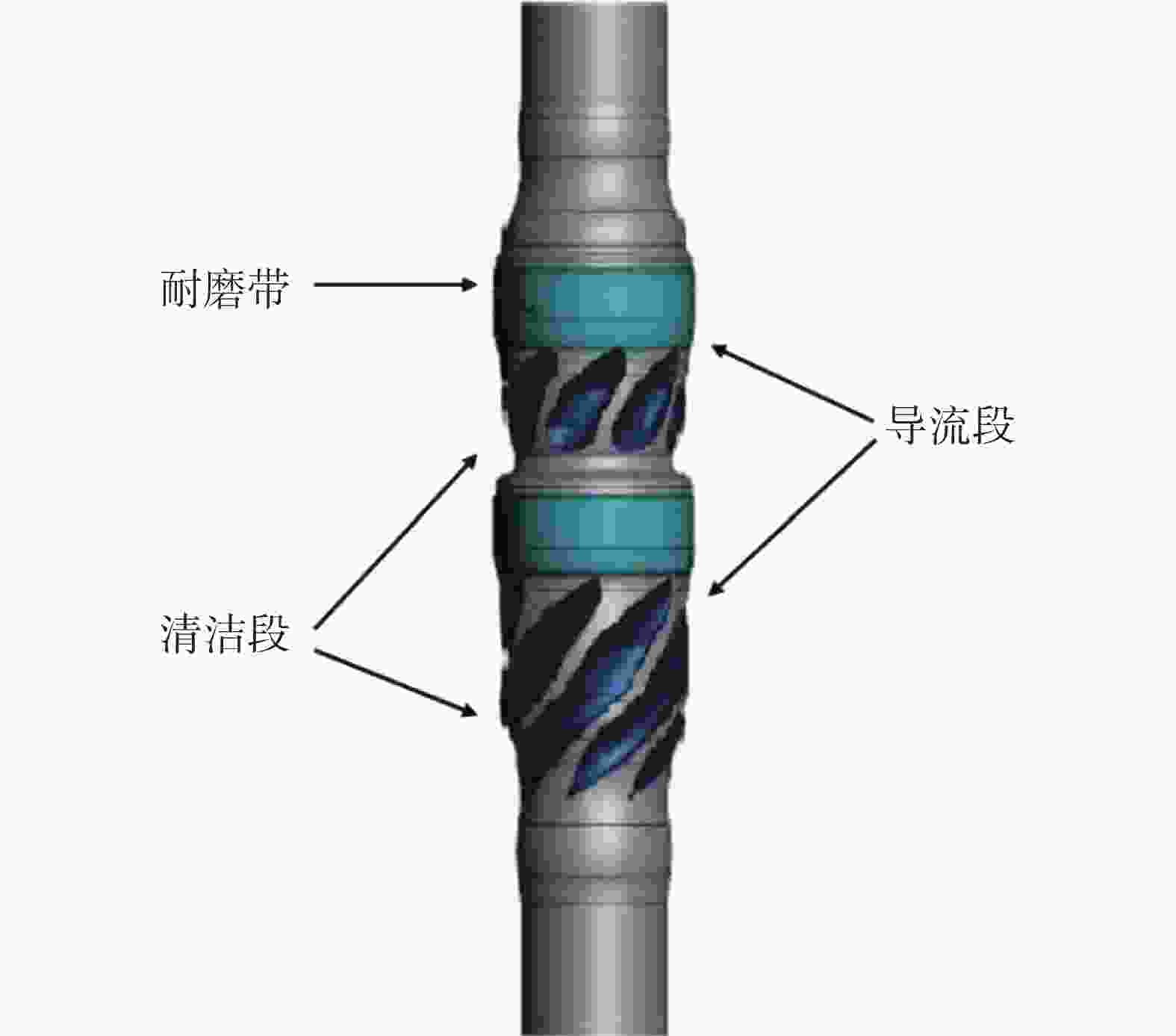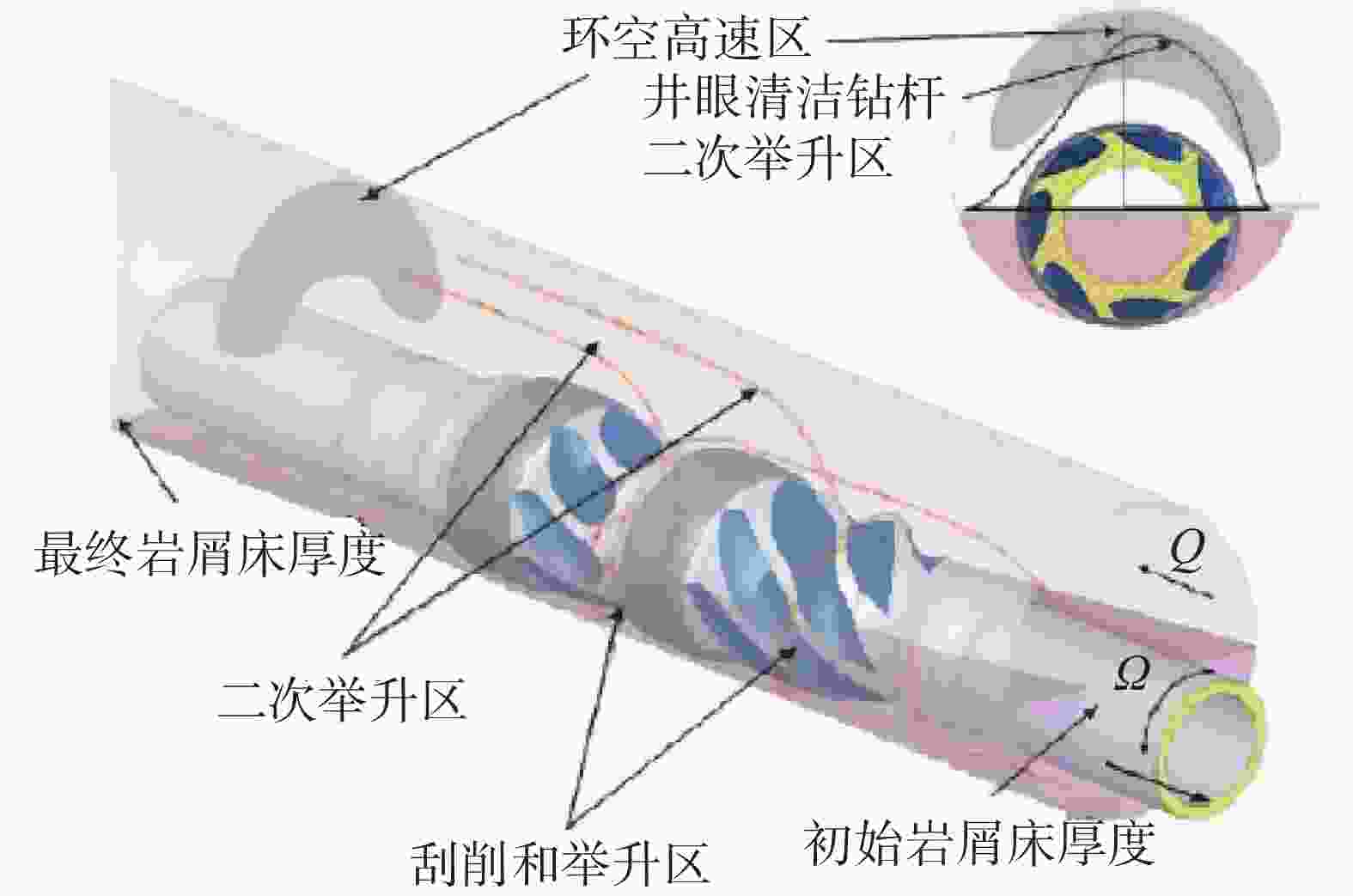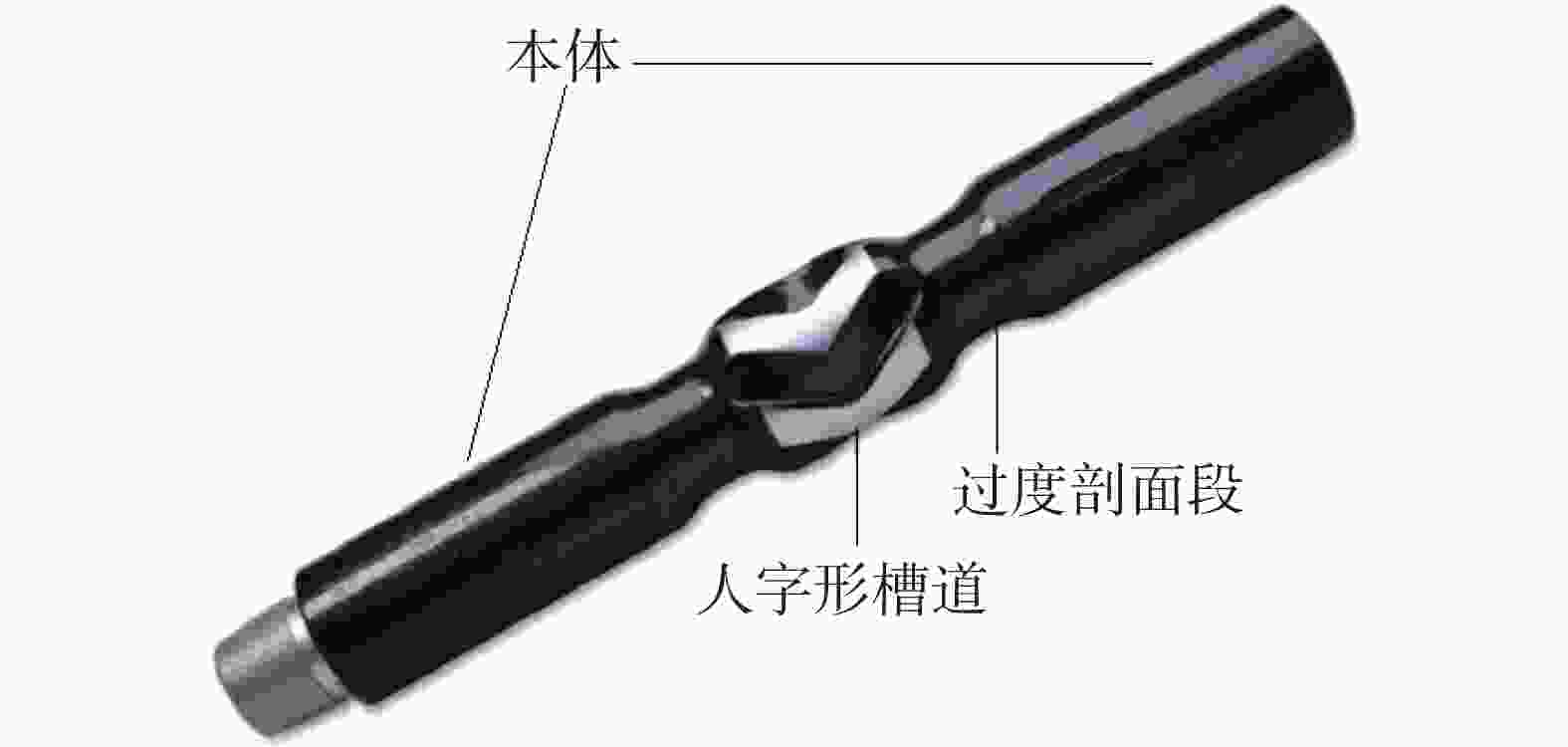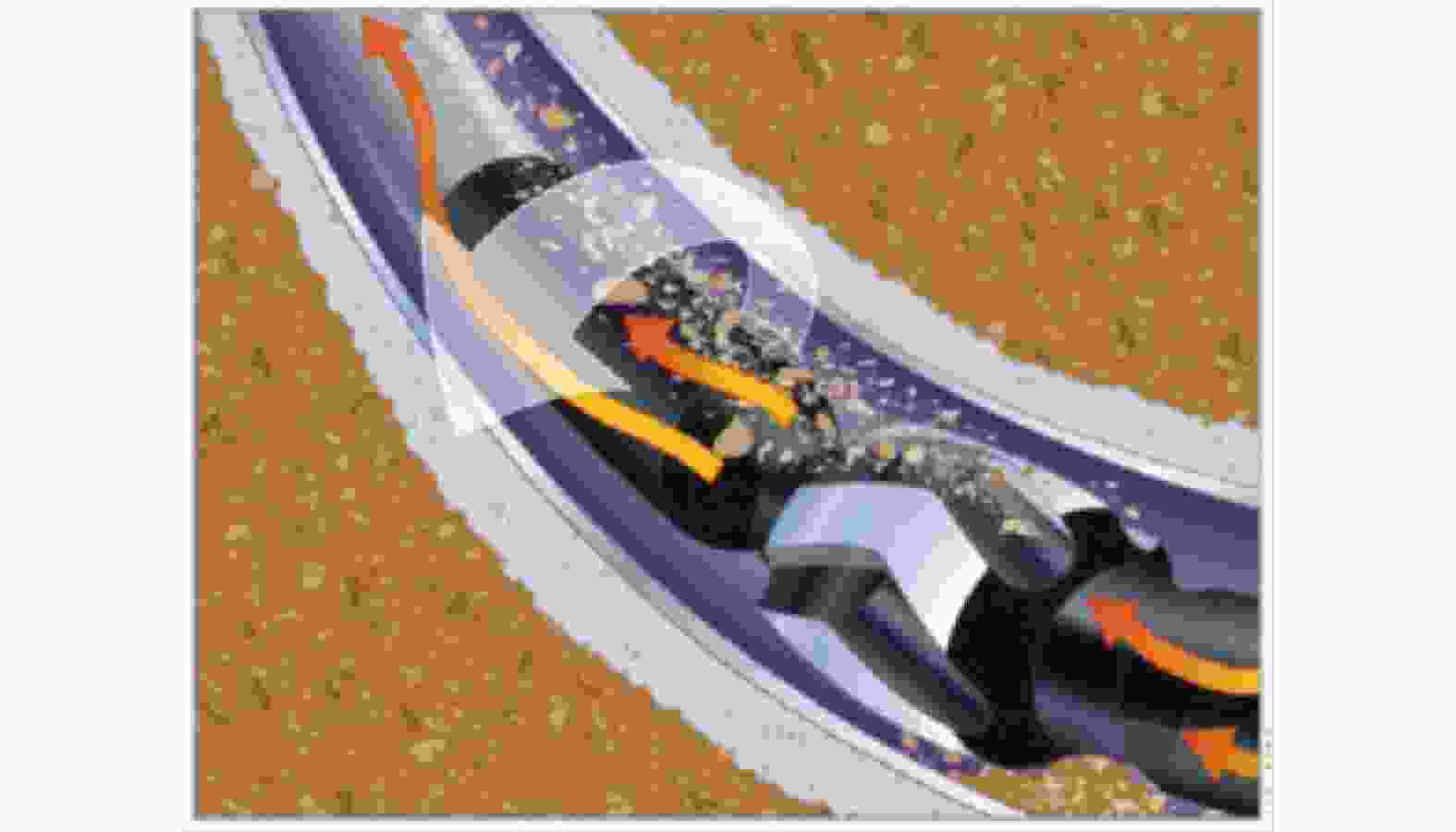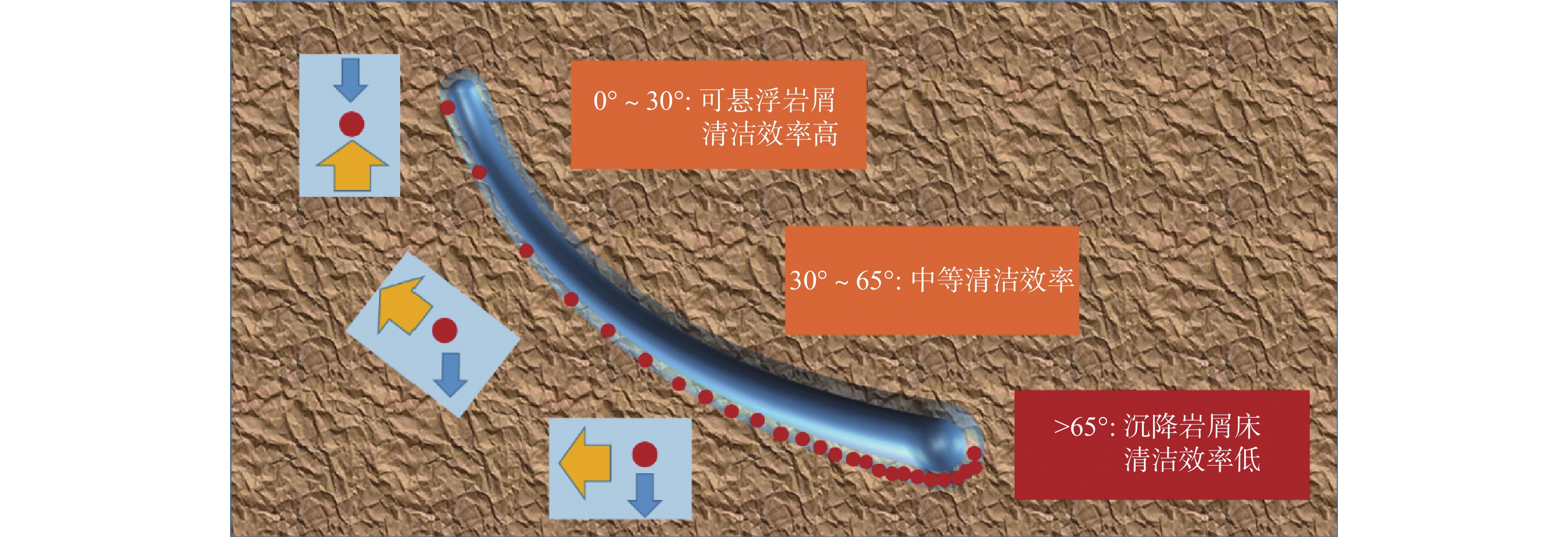Hole Cleaning Technology for Horizontal and Deviated Drilling: Progress Made and Prospect
-
摘要: 水平井钻井技术的进步有利于开发常规和非常规油气储层,然而,与水平段岩屑清除相关的井筒的不稳定性和井眼清洁困难严重制约了钻井生产。井筒岩屑清除效率低下会导致摩阻和扭矩增加、管道卡住,严重时可导致井漏等钻井事故。首先,分别从井眼清洁机理和井眼清洁主要影响因素(钻井液流变性、钻具转速、井角、岩屑尺寸、钻井液密度和流速等)分析综述了水平井和斜井岩屑沉积的成因和适用于现场生产的技术参数。其次,针对水平井和斜井井眼清洁困难分别从国内外钻井液技术和井眼清洁工具两个方面阐述了岩屑清除方法与机理。最后,对水平井和斜井井眼清洁发展方向进行了展望,为未来井眼清洁技术提供了参考。Abstract: Although progresses made in horizontal drilling have been very beneficial to the development of conventional and unconventional oil and gas, two factors related to the cleaning of drilled cuttings from the horizontal section of a well seriously hinder the drilling operation. One of the factors is borehole wall instability, and the other is the difficulties in wellbore cleaning. Inability to remove drilled cuttings from a wellbore in a timely manner often results in increases in friction and torque on the downhole drill string, and the frequency of pipe sticking, and the worse is the simultaneous occurrence of lost circulation. First in this paper, the causes of cuttings bed formation and technical parameters for field operation are analyzed and summarized from two aspects, which are hole cleaning mechanisms and the main factors affecting hole cleaning (mud rheology, pipe rotation, hole inclination, sizes of the drilled cuttings, mud weight and flowrate etc.). Second, the methods and mechanisms of cuttings removal were systematically elaborated from the drilling fluid technologies and hole cleaning tools available both in China and abroad to help deal with the difficulties in hole cleaning in deviated and horizontal drilling. Finally, the development direction for horizontal and deviated hole cleaning technology is prospected to provide a reference for the hole cleaning technology development in the future.
-
Key words:
- Hole cleaning /
- Cuttings bed /
- Horizontal well /
- High inclination well /
- Drilling fluid /
- Tool for cuttings removal /
- Summary
-
表 1 钻井液流型对岩屑运移的影响
范围 钻井液 岩屑尺寸/类型 研究结果 文献 湍流和层流
流速为200~400 gal/min
井角为90°~87°
n/k为 0.004~0.006水基钻井液
(PAC+CMC+XCD)粒径为3.175 mm的粉碎砂岩,密度为2.56 g/cm3 湍流区在所有井角下有利于岩屑运输,该区域不受井筒角度或钻井液流变性的影响 Peter等[10] 湍流和层流
流速为100~200 gal/min
井角为0°~90°膨润土配制的
水基钻井液粒径为6.35 mm的大理石 在湍流条件下,岩屑运输不受流变性的影响 Okrajni and Azar [11] 湍流、过渡和层流
流速为37.9、45.4、53.0及68.1 L/min,井角为60°~90°水基钻井液
(自来水+膨润土+
重晶石+CMC)平均粒径为1.70 mm的
粗砂颗粒对于所有角度的岩屑清除,湍流状态最好,其次是过渡状态,然后是层流状态 Ismail等[12] 湍流和层流
井角为60°~90°
转速为120 r/min水基钻井液
(水+CMC+XC)粒径为1.7~2.0 mm
的硅砂湍流对井眼清洁具有非常强的影响 Peden等[13] 表 2 钻井液流速对井眼清洁的影响
范围 钻井液 岩屑尺寸/类型 研究结果 文献 流速为150~400 gal/min
湍流和层流
井角为90°~87°
n/k 为0.004~0.006水基钻井液
PAC+CMC+
XCD粒径为3.175 mm的粉碎砂岩,密度为2.56 g/cm3 随着流速增加,岩屑床形成时间缩短 Peter等[10] 流速为30~70 m3/h
转速为0和180 r/min
井角为60°水基钻井液
(水+5%膨润土+
0.15%PHPA)密度为2.4 g/cm3、粒径为3.175 mm的球形陶瓷球 在60°时,流速的增加降低了岩屑含量 Naganawa [15] CFD模型
流速为120~180 gal/minCFD模型适用于
不同钻井液粒径为3 mm和8 mm 流速增加了岩屑清除率,小颗粒和较大颗粒清除效果显著 Bilgesu等[16] CFD模型
流速为25~400 gal/min该模型考虑密度为1.0~1.5 g/cm3的
非牛顿流体粒径为0.0457~5.990 mm,密度为2.3~3.0 g/cm3 随着流速增加,岩屑床厚度减小,湍流可阻止岩屑堆积 Ozbayoglu 等[17] 开发的模型对应
每种流速Larsen和Moore
模型的组合岩屑粒径为0.021 mm,密度为2.6 g/cm3 对于特定塑性黏度值和更倾斜的井,岩屑清除所需流速较低 Mohammadsalehi等[14] 表 3 钻井液流变性对岩屑清除率的影响
因素 范围 钻井液 岩屑尺寸/类型 研究结果 文献 n/k 200~250 gal/min
n/k为0.006、0.005、0.004和0.0006水基钻井液
(PAC+CMC+XCD)粒径为3.175 mm的粉碎砂岩,密度为2.56 g/cm3 对于水平井, n/k的降低导致岩屑清除率降低 Peter等[10] 黏度,n 黏度0~300 mPa·s 密度为1.0~1.5 g/cm3的非牛顿流体模型 岩屑粒径为0.0457~5.990 mm,密度为2.3~3.0 g/cm3 黏度增加导致岩屑床厚度增大;高黏度不利湍流 Ozbayoglu 等[17] n为0.2~1.0 减小n值导致岩屑床厚度较小 塑性黏度 0~60 mPa·s CFD模型:Larsen和Moore模型的组合 岩屑粒径为0.021 mm,密度为2.6 g/cm3 塑性黏度增加导致井眼清洁所需流速增大 Mohammadsalehi
等[14]表 4 井角对井眼清洁的影响
范围 钻井液 岩屑尺寸/类型 研究结果 文献 87°和90° 水基钻井液 粒径为3.175 mm的粉碎砂岩,密度为2.56 g/cm3 井角增加导致岩屑床厚度增加 Peter等[10] 0~45°;45°~55°;55°~90° 膨润土配制的
水基钻井液粒径为6.35 mm
的大理石井角增加导致岩屑清除率降低 Okrajni等[11] 60°,70°,80°和90° 水基钻井液(自来水+膨润土+
重晶石+CMC)平均粒径为1.70 mm
的粗砂颗粒井角增加导致岩屑在井筒运移困难 Ismail等[12] 70°~90° 密度为1.0~1.5 g/cm3的
非牛顿流体粒径为0.0457~5.990 mm,密度为2.3~3.0 g/cm3 井角增大,岩屑床厚度增大 Ozbayoglu等[17] 46°和90° CFD模型:Larsen和Moore模型的组合 岩屑粒径为0.021 mm,密度为2.6 g/cm3 井角从46°增加到90°,岩屑清除所需的最小流速增加 Mohammadsalehi等[14] 表 5 钻杆转速对岩屑运移的影响
范围 钻井液 岩屑尺寸/类型 研究结果 文献 0~180 r/min 水基钻井液水+5%膨润土+0.15%PHPA 密度为为2.4 g/cm3、粒径为3.175 mm的球形陶瓷球 钻杆旋转有利于岩屑运移及清除 Naganawa [15] 0~150 r/min 膨润土配制的
水基钻井液6.35 mm大理石 增加钻杆旋转有利于诱导湍流引起的岩屑运移 Okrajni等[11] 0、60、120 r/min 水基钻井液(水+CMC+XC) 1.7~2.0 mm硅砂 钻杆旋转增强了岩屑运移和清除;随着井眼尺寸增加,钻杆旋转的影响较小 Peden等[13] 0、30、60 r/min CFD模型适用于不同钻井液 3 mm和8 mm 钻杆旋转增加了所有流速下的岩屑运移,对小颗粒影响更大 Bilgesu等[16] 0、50、100、150 r/min Herschel-Bulkley液体
泡沫80%和90%密度为2.65 g/cm3的6.35 mm球形砂岩 与偏心环空相比,同心环空中钻杆旋转对岩屑运移影响较小;高转速导致环空中岩屑浓度
较低Heydari等[19] 0、25、50 r/min 反相乳液钻井液 1.2 mm砂粒 旋转速度从0增加到25,水平井中岩屑清除率大幅增加;管道旋转增加到50,斜井(72°)中岩屑清除率显著增加 George等[20] 表 6 聚合物珠对岩屑清除率的影响
表 7 纤维流体的井眼清洁性能
基液 纤维类型 长度/直径 研究结果 文献 0.75%CMC 0.02%~0.10%
单丝合成纤维3.175 mm 纤维导致CMC流体行为发生微小变化,并阻碍了岩屑颗粒的沉降速度 Qingling等[40] 0.47%XG 0.04%合成单丝纤维 10 mm/100 μm 纤维增强了XG的清洁性能,降低了层流下压力损失 Ahmed等[39] 0.5%PAM 0.50%HBS 低浓度HBS可防止岩屑在静态和动态条件下沉降且不影响流体流变性 Movahedi等[41] 1%~6%膨润土浆 0.05%~0.30%
CNF/CNCCNC宽(6.9±2.3) nm,长为(290±31) nm 纤维素纳米颗粒降低了钻井液黏度和凝胶强度 Song等[42] 水/油基钻井液(含聚阴离子纤维素(PAC)) 0~0.08%
合成单丝纤维10 mm/100 μm 纤维降低了球形岩屑颗粒(2~8 mm)的沉降速度 Elgaddafi等[43] 含重晶石的0.5%XG 0.05%合成单丝纤维 纤维流体增强了水平段的岩屑清除 Majidi等[39] 表 8 油基钻井液清除岩屑分析
表 9 泡沫基钻井液对水平井井眼清洁的影响
泡沫质量/% 泡沫速度 研究结果 文献 84~96 在层流条件下,增加泡沫质量可增强岩屑运移 Herzhaft等[61] 84~96 岩屑运移取决于泡沫与钻井液的体积比 Saintpere等[62] 70~90 0.6~5.5 m/s 高质量泡沫增强岩屑运移 Ozbayoglu等[63] 6~95 泡沫在欠平衡钻井中的性能取决于泡沫稳定性 Martins等[64] 70~90 100~200 gal/min 钻杆旋转可在低流速下使用低质量泡沫增强井眼清洁 Xu等[65] 80~90 0.55~1.53 m/s 对于高质量泡沫,泡沫速度增加会降低岩屑运移效率,而钻杆旋转可以增强井眼清洁 Gumati等[66] 70~90 0.61~1.83 m/s 对于高质量泡沫,岩屑运移的速度可增大至1.5 m/s,而低质量泡沫需要更高的速度 Chen等[67] 70~90 0.61~1.83 m/s 使用聚合物和增加气体和液体注入速率可增强泡沫基钻井液对岩屑的运移 Prasun等[68] 60-90 0.61~1.52 m/s 使用低质量泡沫,钻杆旋转可增强岩屑清除 Duan等[57] 气/水 当气体速度增加时,由于局部速度增加,液相对岩屑去除具有显著影响 Ozbayoglu等[69] 气基 岩屑运移取决于钻井液流型 Naganawa等[58] 表 10 不同流体在实验室和现场清除岩屑的应用
配方 实验室 现场 纤维流体 使用纤维会阻碍岩屑沉降[20, 39, 43]高密度纤维增强了静态条件下水平段的岩屑清除[39, 42] 低黏度和高密度纤维在水平井中增强了井眼清洁[74] 水基钻井液油基钻井液,油水比为80/20 水基钻井液和油基钻井液在钻杆旋转时表现出相似的岩屑清除效率,油基钻井液在没有钻杆旋转的情况下岩屑清除效率更高[55, 73] 在低温(50 ℃)下,油基钻井液比KCl水基钻井液井眼清洁效果更好[75] 酯基钻井液 温度和压力对钻井液流变性有影响[54] 基于实验室钻井液流变性的合理控制,实现了有效的井眼清洁[54] 水基钻井液 在低温下水基钻井液有效携带了浅煤层气储层中的岩屑[76] 乙缩醛二乙醇基钻井液 在钻杆旋转下,使用高密度钻井液增强了岩屑运移[53] 合成油基钻井液 低黏度油基钻井液结合钻具旋转缩短了钻井时间,并消除了不良的井眼清洁问题[77] -
[1] 王清臣,张建卿,胡祖彪,等. 长庆气田小井眼钻井液技术研究与应用[J]. 钻井液与完井液,2020,37(6):746-752. doi: 10.3969/j.issn.1001-5620.2020.06.012WANG Qingchen, ZHANG Jianqing, HU Zubiao, et al. Research and application of slim hole drilling fluid technology in Changqing gas field[J]. Drilling Fluid & Completion Fluid, 2020, 37(6):746-752. doi: 10.3969/j.issn.1001-5620.2020.06.012 [2] 刘清友,敬俊,祝效华. 钻柱与实钻水平井眼接触形态及摩阻影响分析[J]. 西南石油大学学报:自然科学版,2017,39(5):163-169.LIU Qingyou, JING Jun, ZHU Xiaohua. Analysis on contact form and friction influence between drill string and actual horizontal borehole[J]. Journal of Southwest Petroleum University:Natural Science Edition, 2017, 39(5):163-169. [3] HM A, AH A, MSN A, et al. Hole cleaning and drilling fluid sweeps in horizontal and deviated wells: Comprehensive review[J]. Journal of Petroleum Science and Engineering, 2020, 186(106748):1-16. [4] 李振川,姚昌顺,胡开利,等. 水平井井眼清洁技术研究与实践[J]. 新疆石油天然气,2022,18(1):48-53. doi: 10.12388/j.issn.1673-2677.2022.01.008LI Zhenchuan, YAO Changshun, HU Kaili, et al. Research and practice of horizontal hole cleaning technology[J]. Xinjiang Petroleum and Natural Gas, 2022, 18(1):48-53. doi: 10.12388/j.issn.1673-2677.2022.01.008 [5] KELESSIDIS V C, BANDELIS G E. Flow patterns and minimum suspension velocity for efficient cuttings transport in horizontal and deviated wells in coiled-tubing drilling[J]. SPE Drilling & Completion, 2004, 19(4):213-227. [6] YEU W J, KATENDE A, SAGALA F, et al. Improving hole cleaning using low density polyethylene beads at different mud circulation rates in different hole angles[J]. Journal of Natural Gas Science and Engineering, 2019, 61:333-343. doi: 10.1016/j.jngse.2018.11.012 [7] HYUN C, SHAH S, OSISANYA S. A three-layer modeling for cuttings transport with coiled tubing horizontal drilling[C]// Proceedings of the Spe Technical Conference & Exhibition, 2000. [8] ASCE. Cuttings transport mechanism in a large-diameter HDD borehole[J]. Journal of Pipeline Systems Engineering & Practice, 2014, 6(4):231-240. [9] 聂勋勇. 大位移井井眼净化的解决方法[J]. 内蒙古石油化工,2014,40(22):42-45. doi: 10.3969/j.issn.1006-7981.2014.22.018NIE Xunyong. Solutions for hole cleaning of extended reach wells[J]. Inner Mongolia Petrochemical, 2014, 40(22):42-45. doi: 10.3969/j.issn.1006-7981.2014.22.018 [10] ADARI R B, MISKA S, KURU E, et al. Selecting drilling fluid properties and flow rates for effective hole cleaning in high-angle and horizontal wells[C]// proceedings of the SPE Annual Technical Conference and Exhibition, SPE-63050-MS, 2000 . [11] OKRAJNI S S, AZAR J J. The effects of mud rheology on annular hole cleaning in directional wells[J]. Spe Drilling Engineering, 1986, 1(4):297-308. doi: 10.2118/14178-PA [12] PIROOZIAN A, ISMAIL I, YAACOB Z, et al. Impact of drilling fluid viscosity, velocity and hole inclination on cuttings transport in horizontal and highly deviated wells[J]. Journal of Petroleum Exploration & Production Technologies, 2012, 2(3):149-156. [13] PEDEN J M, FORD J T, OYENEYIN M B. Comprehensive experimental investigation of drilled cuttings transport in inclined wells including the effects of rotation and eccentricity[C]// European Petroleum Conference. 1990. [14] MOHAMMADSALEHI M, MALEKZADEH N. Optimization of hole cleaning and cutting removal in vertical, deviated and horizontal wells[J]. Society of Petroleum Engineers. 2011, 2(5): 67-79, . [15] NAGANAWA S. Experimental study of effective cuttings transport in drilling highly inclined geothermal wells[J]. Journal of the Japanese Association for Petroleum Technology, 2013, 78(3):257-264. doi: 10.3720/japt.78.257 [16] BILGESU H I, MISHRA N, AMERI S. Understanding the effect of drilling parameters on hole cleaning in horizontal and deviated wellbores using computational fluid dynamics[C]. Proceedings of the Society of Petroleum Engineers, 2007. [17] OZBAYOGLU E M, MISKA S Z, TAKACH N, et al. Sensitivity analysis of major drilling parameters on cuttings transport during drilling highly-inclined wells[J]. Liquid Fuels Technology, 2009, 27(1):122-133. [18] SAASEN A, LKLINGHOLM G. The effect of drilling fluid rheological properties on hole cleaning[C]. proceedings of the IADC/SPE Drilling Conference, 2002. [19] OH A, ES A, PS B. Investigating the impact of drillpipe's rotation and eccentricity on cuttings transport phenomenon in various horizontal annuluses using computational fluid dynamics (CFD)[J]. Journal of Petroleum Science and Engineering, 2017, 156:801-813. doi: 10.1016/j.petrol.2017.06.059 [20] GEORGE M, ELGADDAFI R, AHMED R, et al. Performance of fiber-containing synthetic-based sweep Fluids[J]. Journal of Petroleum Science & Engineering, 2014, 119:185-195. [21] 陈锋,狄勤丰,袁鹏斌,等. 高效岩屑床清除钻杆作用机理[J]. 石油学报,2012,33(2):298-303. doi: 10.7623/syxb201202018CHEN Feng, DI Qinfeng, YUAN Pengbin, et al. Mechanism of high efficiency cutting machine for removing drill pipe[J]. Journal of Petroleum, 2012, 33(2):298-303. doi: 10.7623/syxb201202018 [22] 孙晓峰,闫铁,崔世铭,等. 钻杆旋转影响大斜度井段岩屑分布的数值模拟[J]. 断块油气田,2014,21(1):92-96. doi: 10.6056/dkyqt201401022SUN Xiaofeng, YAN Tie, CUI Shiming, et al. Numerical simulation of the effect of drill pipe rotation on cuttings distribution in highly deviated sections[J]. Block Oil and Gas Field, 2014, 21(1):92-96. doi: 10.6056/dkyqt201401022 [23] WALKER S, LI J. The effects of particle size, fluid rheology, and pipe eccentricity on cuttings transport[C]. proceedings of the SPE/ICoTA Coiled Tubing Roundtable, SPE-60755-MS, 2000. [24] RAMADAN A, SKALLE P, JOHANSEN S T. A mechanistic model to determine the critical flow velocity required to initiate the movement of spherical bed particles in inclined channels[J]. Chemical engineering science, 2003, 58(10):2153-2163. doi: 10.1016/S0009-2509(03)00061-7 [25] YU M, TAKACH N E, NAKAMURA D R, et al. An experimental study of hole cleaning under simulated downhole conditions[C]. proceedings of the Spe Technical Conference & Exhibition, 2007. [26] 陈全发,刘显锋. 提高机械钻速的钻井液理论与技术研究[J]. 中国石油和化工标准与质量,2013,33(20):87-96. doi: 10.3969/j.issn.1673-4076.2013.20.070CHEN Quanfa, LIU Xianfeng. Research on the theory and technology of drilling fluid for improving ROP[J]. China Petroleum and Chemical Standards and Quality, 2013, 33(20):87-96. doi: 10.3969/j.issn.1673-4076.2013.20.070 [27] 邱正松, 刘扣其, 曹杰, 等. 海洋深水"恒流变"油基钻井液实验研究[C]// 2014年度钻井技术研讨会暨第十四届石油钻井院(所)长会议, 中国石油学会, 2014.QIU Zhengsong, LIU Kouqi, CAO Jie, et al. Experimental study on offshore deepwater "constant rheological" oil-based drilling fluid[C]// 2014 Annual Drilling Technology Seminar and the 14th Meeting of Heads of Petroleum Drilling Institutes (Institutes), Chinese Petroleum Society, 2014. [28] 孙金声,苏义脑,罗平亚,等. 超低渗透钻井液提高地层承压能力机理研究[J]. 钻井液与完井液,2005,22(5):1-3.SUN Jinsheng, SU Yinao, LUO Pingya, et al. Study on mechanism of ultra-low permeability drilling fluid improving formation pressure bearing capacity[J]. Drilling Fluid & Completion Fluid, 2005, 22(5):1-3. [29] 张洪泉,任中启,董明健. 大斜度大位移井岩屑床的解决方法[J]. 石油钻探技术,1999,5(3):6-8. doi: 10.3969/j.issn.1001-0890.1999.03.002ZHANG Hongquan, REN Zhongqi, DONG Mingjian. Solution to cutting bed of highly deviated and extended reach wells[J]. Petroleum Drilling Technology, 1999, 5(3):6-8. doi: 10.3969/j.issn.1001-0890.1999.03.002 [30] 张国龙,曹满党,倪益明. 深井大尺寸井眼钻速低的原因及对策[J]. 石油钻探技术,2001,29(2):24-25. doi: 10.3969/j.issn.1001-0890.2001.02.008ZHANG Guolong, CAO Mandang, NI Yiming. Reasons and countermeasures for low penetration rate of large size deep wells[J]. Petroleum Drilling Technology, 2001, 29(2):24-25. doi: 10.3969/j.issn.1001-0890.2001.02.008 [31] Hemphilletal T,于军泉,郭健康. 深水钻井机械钻速的优化: 钻速限度的确定[J]. 石油石化节能,2003,19(7):29-33. doi: 10.3969/j.issn.2095-1493.2003.07.013HEMPHILLETAL T, YU Junquan, GUO Jiankang. Optimization of penetration rate of deepwater drilling machinery: determination of penetration rate limit[J]. Petroleum and Petrochemical Energy Conservation, 2003, 19(7):29-33. doi: 10.3969/j.issn.2095-1493.2003.07.013 [32] 张振兴,李清,阎宏博. "两速"对大斜度井井眼净化的影响[J]. 石油化工应用,2010,29(Z1):90-94. doi: 10.3969/j.issn.1673-5285.2010.02.024ZHANG Zhenxing, LI Qing, YAN Hongbo. The influence of "two speeds" on hole cleaning in highly deviated wells[J]. Petrochemical Application, 2010, 29(Z1):90-94. doi: 10.3969/j.issn.1673-5285.2010.02.024 [33] TAGHIPOUR A, LUND B, YTREHUS J D, et al. Experimental study of hydraulics and cuttings transport in circular and noncircular wellbores[J]. Journal of Energy Resources Technology, 2014, 136(2):022904-022915. doi: 10.1115/1.4027452 [34] 王天成. 提高水平井钻井液携岩能力的实践及认识[J]. 石油钻探技术,1996,24(1):18-21.WANG Tiancheng. Practice and understanding of improving rock carrying capacity of drilling fluid for horizontal wells[J]. Petroleum Drilling Technology, 1996, 24(1):18-21. [35] TAN T Y, ISMAIL I, KATENDE A, et al. Experimental investigation of cuttings lifting efficiency using low and high density polyethylene beads in different hole angles[J]. Journal of Materials Sciences and Applications, 2017, 3:102-115. [36] HAKIM H, KATENDE A, SAGALA F, et al. Performance of polyethylene and polypropylene beads towards drill cuttings transportation in horizontal wellbore[J]. Journal of Petroleum Science & Engineering, 2018, 165:962-969. [37] BOYOU N V, ISMAIL I, HAMZAH M H, et al. Polypropylene beads in water-based mud for cuttings transportation improvement[J]. Chemical Engineering Transactions, 2018, 63:787-792. [38] ONUOHA M, ISMAIL I, PIROOZIAN A, et al. Improving the cuttings transport performance of water-based mud through the use of polypropylene beads[J]. Sains Malaysiana, 2014, 44(4):629-634. [39] MAJIDI R, TAKACH N, TULSA U O, et al. Fiber sweeps improve hole cleaning[J]. American Association of Drilling Engineers, 2015, 12:342-356. [40] LIU Q, TIAN S, SHEN Z, et al. A new equation for predicting settling velocity of solid spheres in fiver containing power-law fluids[J]. Powder Technology:An International Journal on the Science and Technology of Wet and Dry Particulate Systems, 2018, 329:270-281. [41] MOVAHEDI H, FARAHANI M V, JAMSHIDI S. Application of hydrated basil seeds (HBS) as the herbal fiber on hole cleaning and filtration control[J]. Journal of Petroleum Science and Engineering, 2017, 152:212-218. doi: 10.1016/j.petrol.2017.02.014 [42] SONG K, WU Q, LI M C, et al. Performance of low solid bentonite drilling fluids modified by cellulose nanoparticles[J]. Journal of Natural Gas Science & Engineering, 2016, 34:1403-1411. [43] ELGADDAFI R, AHMED R, GEORGE M, et al. Settling behavior of spherical particles in fiber-containing drilling fluids[J]. Journal of Petroleum Science & Engineering, 2012, 84:20-28. [44] GEORGE M, AHMED R, GROWCOCK F. Rheological properties of fiber-containing drilling sweeps at ambient and elevated temperatures[C]. proceedings of the The AADE National Technical Conference and Exhibition, 2011. [45] OSEH J O, NORRDIN M N A M, FAROOQI F, et al. Experimental investigation of the effect of henna leaf extracts on cuttings transportation in highly deviated and horizontal wells[J]. Journal of Petroleum Exploration & Production Technologies, 2019, 9(3):2387-2404. [46] OKON A N, AGWU O E, UDOH F D. SPE-178263-MS Evaluation of the cuttings carrying capacity of a formulated synthetic-based drilling mud[C]. proceedings of the NAICE, 2015. [47] 袁野,蔡记华,王济君,等. 纳米二氧化硅改善钻井液滤失性能的实验研究[J]. 石油钻采工艺,2013,35(3):30-33,41. doi: 10.3969/j.issn.1000-7393.2013.03.010YUAN Ye, CAI Jihua, WANG Jijun, et al. Experimental study on nano silica improving the filtration performance of drilling fluid[J]. Petroleum Drilling and Production Process, 2013, 35(3):30-33,41. doi: 10.3969/j.issn.1000-7393.2013.03.010 [48] 刘凡,蒋官澄,王凯,等. 新型纳米材料在页岩气水基钻井液中的应用研究[J]. 钻井液与完井液,2018,35(1):27-33. doi: 10.3969/j.issn.1001-5620.2018.01.005LIU Fan, JIANG Guancheng, WANG Kai, et al. Application of new nano materials in shale gas water-based drilling fluid[J]. Drilling Fluid & Completion Fluid, 2018, 35(1):27-33. doi: 10.3969/j.issn.1001-5620.2018.01.005 [49] BOYOU N V, ISMAIL I, SULAIMAN W, et al. Experimental investigation of hole cleaning in directional drilling by using nano-enhanced water-based drilling fluids[J]. Journal of Petroleum Science and Engineering, 2019, 176:220-231. doi: 10.1016/j.petrol.2019.01.063 [50] GBADAMOSI A O, JUNIN R, ABDALLA Y, et al. Experimental investigation of the effects of silica nanoparticle on hole cleaning efficiency of water-based drilling mud[J]. Journal of Petroleum Science & Engineering, 2019, 172:1226-1234. [51] ELOCHUKWU H, GHOLAMI R, DOL S S. An approach to improve the cuttings carrying capacity of nanosilica based muds[J]. Journal of Petroleum ence & Engineering, 2017, 152:309-316. [52] 闫丽丽,李丛俊,张志磊,等. 基于页岩气"水替油"的高性能水基钻井液技术[J]. 钻井液与完井液,2015,32(5):1-6.YAN Lili, LI Congjun, ZHANG Zhilei, et al. High performance water-based drilling fluid technology based on shale gas "water replacing oil"[J]. Drilling Fluid & Completion Fluid, 2015, 32(5):1-6. [53] GAO E, YOUNG A C. Hole cleaning in extended reach wells: field experience and theoretical analysis using a pseudo-oil (acetal) based mud[J]. Journal of Petroleum ence & Engineering, 1995, 12:105-121. [54] KENNY P, HEMPHILL T. Hole-cleaning capabilities of an ester-based drilling fluid system[J]. SPE Drilling & Completion, 1996, 11(1):3-10. [55] WERNER B, MYRSETH V, SAASEN A. Viscoelastic properties of drilling fluids and their influence on cuttings transport[J]. Journal of Petroleum Science & Engineering, 2017, 156:845-851. [56] YTREHUS J D, LUND B, TAGHIPOUR A, et al. Cuttings bed removal in deviated wells[C]// proceedings of the ASME 2018 37th International Conference on Ocean, Offshore and Arctic Engineering, 2018. [57] DUAN M, MISKA S, YU M, et al. Experimental study and modeling of cuttings transport using foam with drillpipe rotation[J]. SPE Drilling & Completion, 2010, 25(3):352-362. [58] SHIGEMI N, ATSUSHI O, YOSHIHIRO M, et al. Cuttings transport in directional and horizontal wells while aerated mud drilling[C]// proceedings of the Iadc/spe Asia Pacific Drilling Technology, 2002. [59] 秦国鲲,耿宏章,刘延明,等. 泡沫钻井液动密度随井深变化关系模拟研究[J]. 石油钻探技术,2004,32(5):22-24. doi: 10.3969/j.issn.1001-0890.2004.05.007QIN Guokun, GENG Hongzhang, LIU Yanming, et al. Simulation study on the relationship between dynamic density of foam drilling fluid and well depth[J]. Petroleum Drilling Technology, 2004, 32(5):22-24. doi: 10.3969/j.issn.1001-0890.2004.05.007 [60] YAN T, WANG K, SUN X, et al. State-of-the-art cuttings transport with aerated liquid and foam in complex structure wells[J]. Renewable and Sustainable Energy Reviews, 2014, 37:560-568. doi: 10.1016/j.rser.2014.05.047 [61] HERZHAFT B, TOURE A, BRUNI F, et al. Aqueous foams for underbalanced drilling: The question of solids[C]// proceedings of the SPE Annual Technical Conference and Exhibition, SPE-62898-MS, 2000. [62] SAINTPERE S, MARCILLAT Y, BRUNI F, et al. Hole cleaning capabilities of drilling foams compared to conventional fluids[C]// proceedings of the SPE Annual Technical Conference and Exhibition, SPE-63049-MS, 2000. [63] OZBAYOGLU E M, MISKA S Z, REED T, et al. Cuttings transport with foam in horizontal & highly-inclined wellbores[C]// proceedings of the SPE/IADC Drilling Conference, SPE-79856-MS, 2003. [64] MARTINS A L, LOURENÇO A M F, DE SÁ C H M. Foam property requirements for proper hole cleaning while drilling horizontal wells in underbalanced conditions[J]. SPE Drilling & Completion, 2001, 16(4):195-200. [65] XU J, OZBAYOGLU E, MISKA S, et al. Cuttings transport with foam in highly inclined wells at simulated downhole conditions[J]. Archives of Mining Sciences, 2013, 58(2):481-494. doi: 10.2478/amsc-2013-0032 [66] GUMATI A, TAKAHASHI H, GIWELLI A A. Effect of drillpipe rotation on cuttings transport during horizontal foam drilling[J]. Bulletin of the Japan Petroleum Institute, 2013, 56(4):230-235. doi: 10.1627/jpi.56.230 [67] CHEN Z, AHMED R M, MISKA S Z, et al. Experimental study on cuttings transport with foam under simulated horizontal downhole conditions[J]. SPE Drilling & Completion, 2007, 22(4):304-312. [68] PRASUN S, GHALAMBOR A. Transient cuttings transport with foam in horizontal wells-a numerical simulation study for applications in depleted reservoirs[C]// proceedings of the SPE International Conference and Exhibition on Formation Damage Control, SPE, 2018. [69] OZBAYOGLU E M M, OSGOUEI R E E, OZBAYOGLU A M M, et al. Hole-cleaning performance of gasified drilling fluids in horizontal well sections[J]. SPE Journal, 2012, 17(3):912-923. doi: 10.2118/131378-PA [70] YU M, MELCHER D, TAKACH N, et al. A New Approach to Improve Cuttings Transport in horizontal and inclined wells[C]// proceedings of the SPE Annual Technical Conference and Exhibition, SPE-90529-MS, 2004. [71] YING Ying, LI G C J, LING Li, et al. A novel approach of cuttings transport with bubbles in horizontal wells[J]. Advanced Materials Research, 2012, 524:1314-1317. [72] DENNEY, DENNIS. Cuttings transport with foam under simulated downhole horizontal conditions[J]. Journal of Petroleum Technology, 2006, 58(11):50-51. doi: 10.2118/1106-0050-JPT [73] SAYINDLAA S, LUNDB B, YTREHUSB J D, et al. Hole-cleaning performance comparison of oil-based and water-based drilling fluids[J]. Journal of Petroleum Science and Engineering, 2017, 159:245-261. [74] BULGACHEV R, POUGET P. New experience in monofilament fiber tandem sweeps hole cleaning performance on kharyaga oilfield, timan-pechora region of Russia[C]// proceedings of the SPE Russian Oil and Gas Technical Conference and Exhibition, SPE, 2006. [75] WERNER B, LUND B, MYRSETH V, et al. Comparison of rheological properties of oil-based and KCl drilling fluids[C]. proceedings of the SPE Bergen One Day Seminar, SPE, 2016. [76] LYU S, WANG S, CHEN X, et al. Experimental study of a degradable polymer drilling fluid system for coalbed methane well[J]. Journal of Petroleum Science and Engineering, 2019, 178:678-690. doi: 10.1016/j.petrol.2019.03.065 [77] KOPALLY P, THYAGARAJU B, KALI A. New wells and new challenges: selecting the most appropriate drilling and drilling fluid practices[C]// proceedings of the SPE/IADC Indian Drilling Technology Conference and Exhibition, SPE, 2006. [78] PUYMBROECK L V. Increasing drilling performance using hydro-mechanical hole cleaning devices[M]. Increasing Drilling Performance Using Hydro-Mechanical Hole Cleaning Devices, 2013. [79] 王建龙,郑锋,刘学松,等. 井眼清洁工具研究进展及展望[J]. 石油机械,2018,46(9):18-23. doi: 10.16082/j.cnki.issn.1001-4578.2018.09.004WANG Jianlong, ZHENG Feng, LIU Xuesong, et al. Research progress and prospect of borehole cleaning tools[J]. Petroleum Machinery, 2018, 46(9):18-23. doi: 10.16082/j.cnki.issn.1001-4578.2018.09.004 [80] NWAGU C, AWOBADEJO T, GASKIN K. Application of mechanical cleaning device: hole cleaning tubulars to improve hole cleaning[M]. Application of Mechanical Cleaning Device: Hole Cleaning Tubulars To Improve Hole Cleaning, 2014. [81] SWIETLIK G. Cutting bed impeller: US, 08/877881[P]. 1999-08-17. -




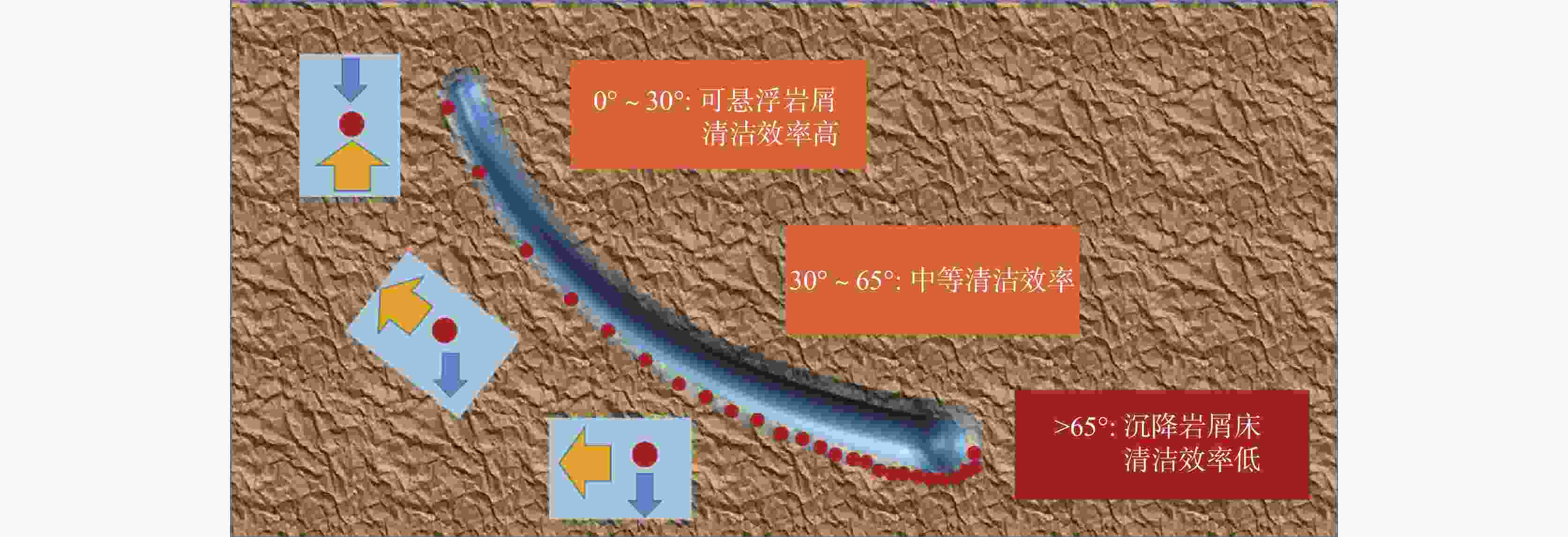
 下载:
下载:
